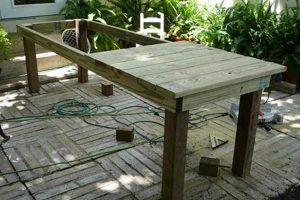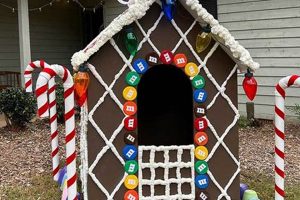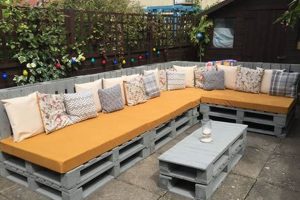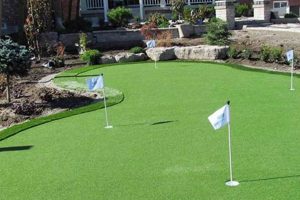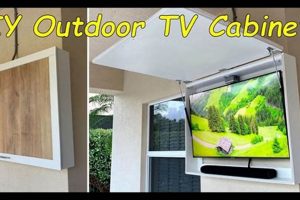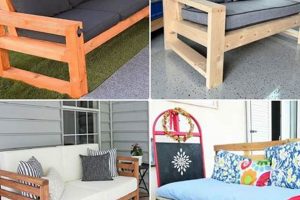The construction of decorative water features in residential exterior spaces, achieved through individual effort rather than professional installation, offers a customizable approach to landscaping. A typical example involves repurposing existing containers, pumps, and tubing to create a recirculating water display for aesthetic enhancement.
This self-directed approach provides considerable cost savings compared to professional installations. Furthermore, it allows for personalized designs that specifically complement the architectural style and garden layout. Historically, individual creation of landscape elements has fostered a sense of ownership and connection to the outdoor environment, promoting well-being and appreciation of natural resources.
The subsequent sections will delve into the practical considerations involved in planning and building such a project, including material selection, pump sizing, water management, and safety precautions.
Construction Recommendations for Personalized Exterior Water Features
The following recommendations aim to ensure a successful and enduring outcome when undertaking the construction of personalized exterior water features. Adherence to these principles will minimize potential challenges and maximize the aesthetic and functional longevity of the feature.
Tip 1: Site Assessment is Critical: Prior to commencement, thoroughly evaluate the intended location. Consider sun exposure, proximity to power outlets, and the level of the ground. Uneven terrain necessitates leveling to ensure proper water distribution and pump function. Proximity to deciduous trees should also be considered due to leaf debris.
Tip 2: Pump Selection Based on Flow Rate and Head: Correct pump sizing is essential. Calculate the required flow rate (gallons per hour) based on the feature’s dimensions and desired water effect. “Head” refers to the vertical distance the pump must lift the water. Select a pump with sufficient capacity for both flow and head to prevent premature failure.
Tip 3: Implement Effective Water Containment: Choose a durable and watertight basin material. Concrete, heavy-duty plastic liners, or sealed metal containers are suitable options. Ensure all seams and connections are properly sealed to prevent water loss and potential damage to surrounding landscape.
Tip 4: Prioritize Electrical Safety: Employ a Ground Fault Circuit Interrupter (GFCI) protected outlet for the pump. Water and electricity present a significant hazard. All electrical connections must be weatherproof and properly insulated. Consider burying electrical conduits to protect them from environmental exposure and physical damage.
Tip 5: Filtration is Essential for Water Clarity: Integrate a filtration system to remove debris and algae. This can range from a simple sponge filter to a more complex biological filter. Regular cleaning of the filter is crucial to maintain water clarity and prevent pump blockage.
Tip 6: Consider Winterization Strategies: In regions with freezing temperatures, implement winterization procedures. Drain the water feature completely to prevent ice damage. Remove the pump and store it indoors. Cover the basin to prevent debris accumulation.
Tip 7: Regular Maintenance is Required: Periodic maintenance is necessary to ensure the longevity of the feature. This includes cleaning the basin, checking for leaks, and inspecting the pump for wear and tear. Prompt attention to minor issues will prevent more significant problems in the future.
Successful implementation of these recommendations will result in a visually appealing and functionally reliable personalized exterior water feature, enhancing the aesthetic value and tranquility of the outdoor environment.
The following section provides an overview of common design approaches, offering inspiration for personalized creations.
1. Planning
Effective planning forms the cornerstone of any successful exterior water feature project. A lack of adequate planning can lead to structural instability, water leaks, inefficient water circulation, and ultimately, project failure. For instance, neglecting to accurately assess the terrain prior to construction might necessitate costly and time-consuming leveling adjustments. A preliminary sketch detailing dimensions, material selection, and plumbing layout minimizes errors and ensures a cohesive design.
The selection of an appropriate location is integral to the planning process. Factors such as sunlight exposure, wind patterns, and proximity to electrical outlets have direct implications for plant growth within or around the fountain, water evaporation rates, and the feasibility of powering the recirculation pump. Omitting this step might result in suboptimal performance, requiring relocation and additional expense. Another planning consideration involves the design’s compatibility with the surrounding landscape architecture. A fountain that clashes with the existing garden style detracts from the overall aesthetic appeal.
In summary, comprehensive planning is not merely a preliminary step but rather an integral component that dictates the ultimate success or failure. It mitigates potential challenges, optimizes performance, and guarantees a seamless integration with the existing environment. Neglecting detailed planning introduces avoidable risks and diminishes the value of the completed outdoor water feature. The time invested in thorough planning yields tangible benefits throughout the project’s lifecycle.
2. Materials
Material selection directly influences the aesthetic appeal, durability, and environmental impact of any self-constructed outdoor water feature. The chosen components dictate the overall visual character, ranging from rustic natural stone to sleek modern metal. Furthermore, the material’s resistance to weather conditions, such as freeze-thaw cycles and prolonged sun exposure, determines the lifespan of the creation. Improper selection can lead to premature degradation, necessitating costly repairs or complete replacement. For example, using porous sandstone in a region with frequent freezing temperatures without proper sealing will result in cracking and disintegration over time.
Beyond durability, the environmental implications of material choice warrant careful consideration. Reclaimed materials, such as repurposed containers or recycled glass, offer a sustainable alternative to newly manufactured products, reducing the carbon footprint of the project. Conversely, the use of chemically treated lumber or non-recyclable plastics can contribute to environmental pollution. Consider the weight as well as the strength of the material. Selecting lightweight material, such as plastic, can make a fountain more easy to move around, clean, or change in a long period of time. On the other hand, heavy materials, like stone or concrete, can ensure that the water fountain is much more solid and safe in certain outdoor conditions.
Therefore, informed material selection represents a crucial element in the successful construction of a personalized outdoor water feature. Careful evaluation of aesthetic preferences, environmental impact, and long-term durability considerations promotes responsible resource management and ensures the enduring beauty and functionality of the finished product. Ignoring material properties introduces avoidable risks and undermines the project’s sustainability and visual harmony.
3. Pump Sizing
Pump sizing constitutes a critical determinant in the successful operation of any self-constructed exterior water feature. The selection of an inadequately sized pump invariably leads to diminished performance, characterized by weak water flow, inadequate aeration, and potential overheating. Conversely, an oversized pump consumes excessive energy, generates unnecessary noise, and may create turbulent water conditions detrimental to the aesthetic appeal of the feature. An underpowered pump might barely trickle water, failing to produce the intended visual effect. Over time, attempting to operate an undersized pump beyond its capacity causes premature wear and failure. For example, a pump rated for 200 gallons per hour (GPH) attempting to circulate water through a complex series of tiered fountains requiring 400 GPH will likely burn out quickly, rendering the entire feature inoperative.
The process of pump sizing necessitates a comprehensive understanding of the water feature’s design parameters. The vertical distance the water must be lifted (referred to as “head”) directly impacts the pump’s required power. Similarly, the volume of water the feature contains influences the necessary flow rate. A simple calculation involving these variables provides a starting point for pump selection. However, real-world factors, such as frictional losses in the plumbing and the desired water pattern, require adjustments to this initial estimate. For example, a fountain incorporating long stretches of narrow tubing will require a more powerful pump to overcome the increased resistance to water flow. Accurate pump sizing ensures optimal water circulation, promoting healthy plant growth (if incorporated) and preventing the accumulation of stagnant water that can attract pests and breed algae.
In conclusion, appropriate pump sizing is not merely a technical detail but rather a fundamental aspect of constructing a functional and visually appealing personalized exterior water feature. An informed decision, based on accurate calculations and a thorough understanding of the feature’s design, maximizes energy efficiency, minimizes maintenance, and guarantees the long-term viability of the project. Neglecting this aspect leads to performance compromises, increased operating costs, and potential component failures, ultimately diminishing the value and enjoyment derived from the outdoor water feature.
4. Waterproofing
Waterproofing constitutes a foundational element in the successful and enduring construction of any self-directed outdoor water feature. Its primary function is to prevent water leakage, thereby safeguarding the structural integrity of the feature and preventing damage to surrounding landscaping or property. Neglecting proper waterproofing protocols can result in significant water loss, potential structural compromise, and costly remediation efforts.
- Liner Selection and Installation
The selection of an appropriate liner material is paramount. Options include flexible pond liners (typically PVC or EPDM rubber), rigid pre-formed liners, and concrete sealants. Flexible liners must be carefully installed to avoid punctures or tears, often requiring an underlayment to protect against sharp objects. Rigid liners offer greater structural support but may be less adaptable to irregular shapes. Improperly installed liners, regardless of material, can lead to significant leaks and require complete replacement.
- Sealing Joints and Connections
In water features constructed from multiple components (e.g., stacked stones or concrete blocks), the sealing of joints and connections is essential. Specialized waterproof sealants or mortars designed for aquatic environments must be employed. These materials must be compatible with the construction materials and resistant to degradation from constant water exposure and UV radiation. Failure to properly seal these joints results in gradual water seepage and potential structural weakening due to water infiltration.
- Concrete Waterproofing Techniques
For concrete water features, integral waterproofing admixtures or surface-applied sealants are frequently used. Integral admixtures are added to the concrete mix, creating a waterproof barrier throughout the material. Surface sealants are applied after the concrete has cured, providing a protective layer against water penetration. Both methods require careful application according to manufacturer specifications to ensure effectiveness. Improper mixing ratios or inadequate surface preparation can compromise the waterproofing properties of the concrete.
- Maintaining Waterproofing Integrity
Even with proper initial waterproofing, ongoing maintenance is necessary to ensure long-term effectiveness. This includes regularly inspecting the liner or sealant for cracks, tears, or degradation. Prompt repairs using appropriate patching materials or sealants can prevent minor issues from escalating into major leaks. Furthermore, protecting the water feature from physical damage (e.g., from gardening tools or freezing temperatures) helps preserve the integrity of the waterproofing system.
In essence, effective waterproofing is not merely an optional addition but rather an indispensable component of any DIY outdoor water feature project. Diligent attention to liner selection, joint sealing, concrete waterproofing techniques, and ongoing maintenance ensures a watertight and structurally sound feature, maximizing its longevity and preventing costly repairs. A poorly waterproofed feature represents a significant risk of water damage and undermines the overall value and enjoyment of the outdoor space.
5. Filtration
Filtration constitutes an indispensable element within a self-constructed outdoor water feature, directly impacting water clarity, system longevity, and ecological balance. Its implementation mitigates the accumulation of debris, minimizes algae growth, and prolongs the operational lifespan of the circulation pump.
- Mechanical Filtration: Removal of Particulate Matter
Mechanical filtration employs physical barriers, such as sponges, filter pads, or gravel beds, to trap suspended solids. Leaves, sediment, and other debris are captured, preventing them from clouding the water and clogging the pump intake. Regular cleaning or replacement of these filters is essential to maintain optimal flow and prevent the buildup of organic material that can fuel algae growth. Ineffective mechanical filtration results in murky water and increased maintenance requirements.
- Biological Filtration: Nitrification and Water Purification
Biological filtration leverages beneficial bacteria to convert harmful ammonia and nitrites into less toxic nitrates. This process, known as nitrification, occurs within a porous medium, such as lava rock or ceramic bio-balls, providing a surface area for bacterial colonization. These bacteria consume organic waste, naturally purifying the water. Without adequate biological filtration, ammonia and nitrite levels can rise, creating an unhealthy environment for aquatic life and promoting algae blooms. The bacteria will also aid in keeping the pumps clear of debris for longevity of the pump itself.
- Chemical Filtration: Adsorption of Dissolved Contaminants
Chemical filtration utilizes materials, such as activated carbon or zeolite, to adsorb dissolved contaminants, including chlorine, tannins, and heavy metals. Activated carbon effectively removes odors and discoloration, while zeolite can reduce ammonia levels. Chemical filtration is particularly beneficial in water features using tap water, which may contain chlorine or chloramine. Periodic replacement of these filtration media is necessary as they become saturated with contaminants. This will help your pond look much more appealing.
- Ultraviolet (UV) Sterilization: Algae and Pathogen Control
Ultraviolet (UV) sterilizers employ UV light to kill algae, bacteria, and other microorganisms suspended in the water. UV sterilization does not remove debris but rather disrupts the cellular structure of these organisms, preventing them from reproducing. This method is particularly effective at controlling green water algae, resulting in clear, aesthetically pleasing water. UV sterilizers require periodic replacement of the UV bulb to maintain optimal performance.
Integrating these filtration methods into a self-constructed water feature creates a balanced ecosystem, promoting water clarity, minimizing maintenance, and fostering a healthy environment for any aquatic plants or animals. The absence of effective filtration compromises water quality, accelerates pump wear, and detracts from the aesthetic appeal of the feature. The combination of these methods helps to ensure the longevity of your feature.
6. Electrical Safety
The intersection of electrical systems and water sources in a self-constructed outdoor water feature environment presents significant safety hazards. Electrical faults, caused by damaged wiring or inadequate insulation, can energize the surrounding water, posing a severe electrocution risk to individuals who come into contact with it. Ground Fault Circuit Interrupters (GFCIs) serve as a primary safety mechanism by detecting imbalances in electrical current, indicating a potential leakage, and immediately cutting off power to the circuit. A scenario involving a submerged pump with a compromised power cord illustrates this danger; without a GFCI, the water becomes electrified, endangering anyone who interacts with the fountain. Proper electrical grounding is critical to ensure that stray currents are safely directed away, minimizing the risk of electric shock.
Implementing best practices for electrical installations, such as burying electrical conduits below ground and using weatherproof enclosures for electrical connections, is essential for mitigating potential hazards. Direct burial of non-rated electrical cables exposes them to moisture and physical damage, increasing the likelihood of shorts and ground faults. All electrical work should comply with local electrical codes and be performed by qualified personnel to guarantee adherence to safety standards. Regularly inspecting electrical components for wear, damage, or corrosion is also a fundamental preventative measure. Damaged or corroded wiring represents an increased risk of electrical failure and potential hazards.
In conclusion, maintaining stringent electrical safety standards is paramount when constructing a DIY outdoor water feature. The inherent risks associated with combining electricity and water necessitate the implementation of multiple layers of protection, including GFCIs, proper grounding, code-compliant wiring practices, and routine inspections. Failure to prioritize electrical safety can result in serious injury or fatal accidents. Therefore, thorough planning and meticulous execution of electrical work are non-negotiable aspects of creating a safe and enjoyable water feature.
Frequently Asked Questions
The subsequent questions address common concerns and misconceptions regarding the construction of a personalized outdoor water feature. The information provided aims to clarify technical aspects and guide informed decision-making.
Question 1: What constitutes the minimum acceptable depth for a basin in a region experiencing sub-freezing temperatures?
A minimum depth of 18 inches is generally recommended. This depth provides sufficient thermal mass to mitigate the effects of surface freezing and protect submerged components from ice damage. However, complete drainage and component removal remain the most effective winterization strategies.
Question 2: Is it permissible to utilize standard household extension cords to power a recirculation pump situated outdoors?
The use of standard household extension cords is strongly discouraged. Only outdoor-rated extension cords, specifically designed for wet environments and UV exposure, should be employed. These cords are constructed with heavier insulation and are more resistant to environmental degradation, minimizing the risk of electrical shock.
Question 3: What is the recommended frequency for cleaning a mechanical filter within a typical outdoor water feature?
Cleaning frequency is contingent upon environmental factors, such as proximity to deciduous trees and the presence of aquatic life. A visual inspection should be conducted weekly. Cleaning or replacement is indicated when the filter becomes visibly clogged or when water flow is noticeably reduced. Typically, cleaning will be needed on bi-weekly or monthly basis.
Question 4: Does the addition of chlorine constitute an acceptable method for algae control in a water feature containing aquatic plants?
The addition of chlorine is generally discouraged, as it can be detrimental to aquatic plants and beneficial bacteria essential for biological filtration. Alternative algae control methods, such as UV sterilization or the introduction of algae-eating fish (in larger features), are preferable.
Question 5: What type of sealant is recommended for bonding natural stones in a tiered fountain construction?
A silicone-based sealant specifically formulated for aquatic applications is recommended. This type of sealant exhibits excellent adhesion to stone surfaces, remains flexible after curing to accommodate thermal expansion and contraction, and is non-toxic to aquatic life. If the stones are very heavy a more permanent solution might be needed in place of the sealant.
Question 6: How often should the water in a DIY outdoor water fountain be completely changed?
Complete water changes are generally unnecessary if an effective filtration system is in place. Regular topping off to compensate for evaporation is typically sufficient. A complete water change may be warranted if significant contamination occurs (e.g., introduction of pollutants or excessive algae bloom) that cannot be addressed by filtration alone. You’ll want to make sure that your water is as clean as possible.
The preceding questions and answers highlight the importance of informed decision-making throughout the construction and maintenance of a personalized outdoor water feature. Proper planning and best practices help ensure safety and longevity.
The subsequent section presents diverse design examples, providing a source of inspiration for personalized creations.
Conclusion
The preceding exploration of “diy outdoor water fountain” construction has underscored the critical importance of comprehensive planning, informed material selection, appropriate pump sizing, robust waterproofing, effective filtration, and rigorous adherence to electrical safety standards. These interconnected elements, when meticulously addressed, contribute to the creation of a durable, aesthetically pleasing, and environmentally responsible water feature. The failure to adequately consider any of these factors can lead to compromised performance, increased maintenance demands, potential safety hazards, and ultimately, project failure.
The creation of personalized water features represents a significant undertaking, requiring both technical knowledge and meticulous execution. Responsible implementation of the principles outlined herein ensures a rewarding and enduring enhancement to the outdoor environment. Continued adherence to best practices in construction and maintenance remains paramount for maximizing the long-term value and enjoyment derived from these installations.


